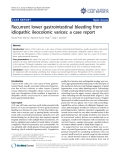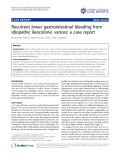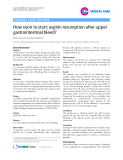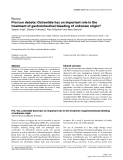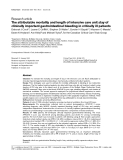
Gastrointestinal bleeding
-
To assess clinical and subclinical characteristics of Dengue pediatric patients with gastrointestinal bleeding in Nhi Dong 1 Hospital from 12/2014 to 12/2015. To evaluate the relationship between gastrointestinal bleeding and clinical, subclinical characteristics and virus type of Dengue pediatric patients at Nhi Dong 1 Hospital from 12/2014 to 12/2015.
 30p
30p  angicungduoc6
angicungduoc6
 21-07-2020
21-07-2020
 20
20
 3
3
 Download
Download
-
Tham khảo luận văn - đề án 'báo cáo y học: " recurrent lower gastrointestinal bleeding from idiopathic ileocolonic varices: a case report"', luận văn - báo cáo phục vụ nhu cầu học tập, nghiên cứu và làm việc hiệu quả
 4p
4p  thulanh27
thulanh27
 12-12-2011
12-12-2011
 48
48
 3
3
 Download
Download
-
Tuyển tập báo cáo các nghiên cứu khoa học quốc tế ngành y học dành cho các bạn tham khảo đề tài: Recurrent lower gastrointestinal bleeding from idiopathic ileocolonic varices: a case report...
 4p
4p  thulanh26
thulanh26
 09-12-2011
09-12-2011
 51
51
 3
3
 Download
Download
-
Tuyển tập các báo cáo nghiên cứu về y học được đăng trên tạp chí y học Critical Care giúp cho các bạn có thêm kiến thức về ngành y học đề tài: How soon to start: aspirin resumption after upper gastrointestinal bleed?
 2p
2p  thulanh18
thulanh18
 05-11-2011
05-11-2011
 47
47
 2
2
 Download
Download
-
Tuyển tập các báo cáo nghiên cứu về y học được đăng trên tạp chí y học Critical Care cung cấp cho các bạn kiến thức về ngành y đề tài: Pro/con debate: Octreotide has an important role in the treatment of gastrointestinal bleeding of unknown origin?
 4p
4p  thulanh17
thulanh17
 24-10-2011
24-10-2011
 53
53
 4
4
 Download
Download
-
Tuyển tập các báo cáo nghiên cứu về y học được đăng trên tạp chí y học General Psychiatry cung cấp cho các bạn kiến thức về ngành y đề tài: The attributable mortality and length of intensive care unit stay of clinically important gastrointestinal bleeding in critically ill patients...
 8p
8p  thulanh16
thulanh16
 22-10-2011
22-10-2011
 57
57
 5
5
 Download
Download
-
Tuyển tập báo cáo các nghiên cứu khoa học quốc tế ngành y học dành cho các bạn tham khảo đề tài: A Review of Duodenal Metastases from Squamous Cell Carcinoma of the Cervix Presenting as an Upper Gastrointestinal Bleed
 17p
17p  hoami_238
hoami_238
 11-10-2011
11-10-2011
 65
65
 4
4
 Download
Download
-
1/ CÁC LOẠI XUẤT HUYẾT ĐƯỜNG TIÊU HÓA KHÁC NHAU ? Cách thông thường nhất và hữu ích trên phương diện lâm sàng là phân chia xuất huyết đường dạ dày-ruột (gastrointestinal tract bleeding) thành xuất huyết ở phần trên và phần dưới. Sự xác định này cho ta một ý nghĩ về căn nguyên, tiên lượng, và cách điều trị.
 9p
9p  tuoanh04
tuoanh04
 07-07-2011
07-07-2011
 58
58
 5
5
 Download
Download
-
Bệnh nhân là một đàn bà 65 tuổi uống thuốc Aspirine và thuốc trị phong thấp (nonsteroid anti-inflammatory drug, NSAIDs) . Bệnh nhân vào nhà thương cấp cứu vì đi cầu ra phân đen một tuần lễ liên tục. Thử máu cho thấy bị thiếu máu. Bệnh nhân chưa bao giờ bị chảy máu đường ruột. Chưa bao giờ bị ói ra máu và không than phiền bị đau bụng. Khám nghiệm thấy bệnh nhân không bị dị ứng cho bất cứ thuốc gì trước đây. Hiện đang bị cao máu, cao mỡ, và loãng xương. Chưa bao giờ...
 6p
6p  sinhtobo111
sinhtobo111
 13-04-2011
13-04-2011
 61
61
 3
3
 Download
Download
-
Nôn ra máu (hematemesis) có thể thay đổi từ chất giống bã cà phê (máu đậm màu do tiếp xúc với acide) đến máu đỏ tươi số lượng lớn. Đại tiện máu đen (melena) (đen, như hắc ín) thường được nhận thấy nơi những bệnh nhân với xuất huyết dạ dày-ruột trên nhưng có thể được thấy nơi những bệnh nhân chảy máu đại tràng phải với nhu động chậm. Xuất huyết dạ dày-ruột trên với tốc độ nhanh có thể đưa đến phân màu đỏ. ...
 18p
18p  thiuyen111
thiuyen111
 11-04-2011
11-04-2011
 63
63
 5
5
 Download
Download
-
CÁC LOẠI XUẤT HUYẾT ĐƯỜNG TIÊU HÓA KHÁC NHAU ? Cách thông thường nhất và hữu ích trên phương diện lâm sàng là phân chia xuất huyết đường dạ dày-ruột (gastrointestinal tract bleeding) thành xuất huyết ở phần trên và phần dưới. Sự xác định này cho ta một ý nghĩ về căn nguyên, tiên lượng, và cách điều trị. - Xuất huyết dạ dày-ruột trên (upper gastrointestinal tract bleeding) : bao gồm xuất huyết ở phần gần so với tá tràng (duodenum). ...
 20p
20p  thiuyen111
thiuyen111
 11-04-2011
11-04-2011
 77
77
 6
6
 Download
Download
-
Phạm vi vấn đề - Chảy máu tiêu hó có thể xảy ra ở bất cứ vị trí nào dọc theo đường dạ dày ruột .Tính nguy hiểm của chảy máu có thể thay đổi từ chảy máu trực
 9p
9p  hoangsinh280387
hoangsinh280387
 11-01-2010
11-01-2010
 114
114
 29
29
 Download
Download
CHỦ ĐỀ BẠN MUỐN TÌM









